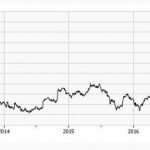A eurodollar futures contract affords the buyer the opportunity to obtain a $1 million eurodollar deposit for a three-month term at the expiration and execution of the contract. The rate to be paid for that deposit is 100 points minus 3-month LIBOR for spot settlement on the 3rd Wednesday of the contract month. If 3-month LIBOR on June 20, 2018 is, for the sake of argument, 1%, then the June 2018 contract itself will price 99.00 at that expiration. You are essentially buying into a discounted view of future money rates.
Because we are dealing with prices and views on rates into the future, there are different perhaps seemingly conflicted sets of risks and parameters. This is especially true when examining the current offerings in LIBOR. If eurodollar futures are predicated upon future LIBOR rates, why do they seem to move opposite to current LIBOR? The London rate has been rising for more than a year and a half going back, importantly, to December 2014. Yet, during that time eurodollar futures all over the curve have been rising (in price), too. That seems to be conflicting information as one would expect the current price of LIBOR to get discounted into the futures price.
After all, if LIBOR is rising today as a result of “normalization” of interest rates after so many years of ZIRP, it stands to reason that such a benign (that is, rising rates not predicated upon rising risks, rather as a matter of intentional policy changes) increase would be passed along into the futures market. If 3-month LIBOR was to hit 90 bps as a matter of normalization, then the June 2018 futures price, you would think, would take that 90 bps as a starting point.
The current June 2018 price is around 98.80, meaning there is very little time value (just less than two years) reflected in that price given 3-month LIBOR is currently fixed above 83 bps. In fact, eurodollar futures have been rising as LIBOR has been rising, suggesting that normalization is not the primary discounting mechanism.
Since LIBOR is a reflection of money rates at different maturities as of right now, where eurodollar futures are a reflection of money rates as of that future point, these two related rates do not necessarily need to be directly translatable. When rising risk rather than benignity is indicated, rising LIBOR (current) alongside rising eurodollar futures prices (future) is easily interpreted as the former leading to the latter. In other words, where rising LIBOR right now would suggest increasing credit or (more so) liquidity risks, rising eurodollar futures suggest the ultimate economic damage those risks are expected to unleash if left unchecked.












Leave A Comment